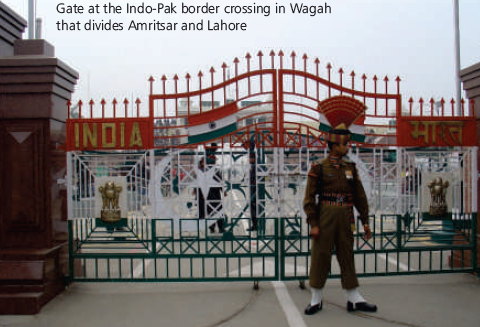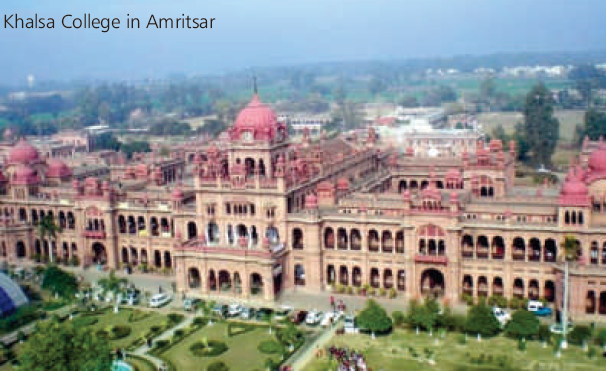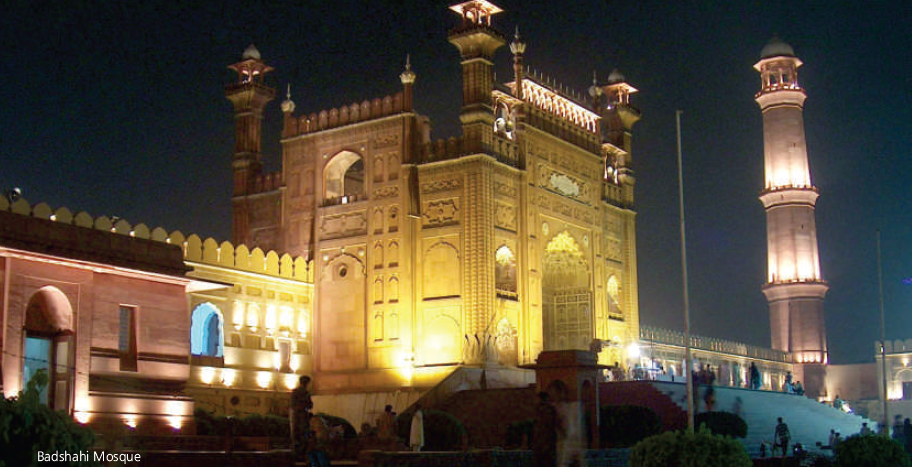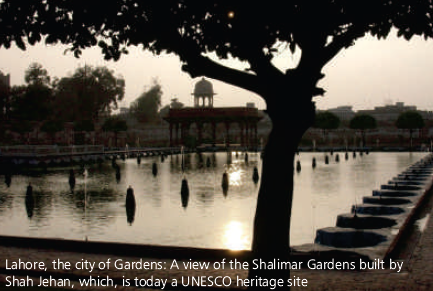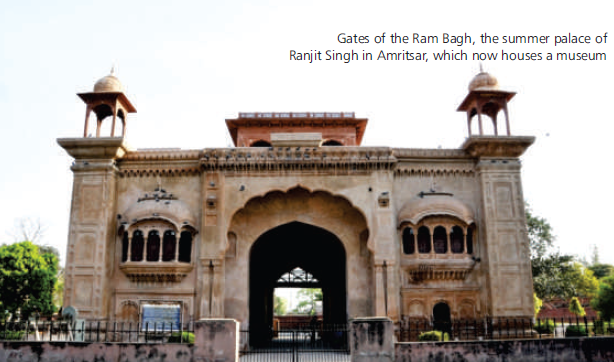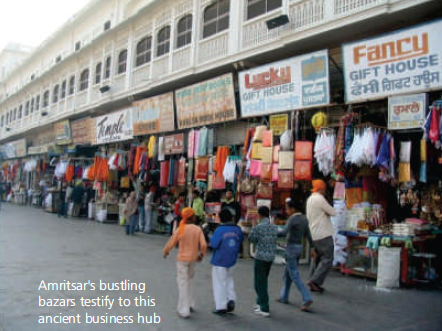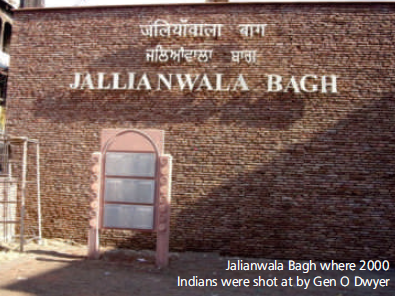Lahore & Amritsar
This is a collection of articles archived for the excellence of their content. Readers will be able to edit existing articles and post new articles directly |
Lahore & Amritsar
A shared cultural landscape
India Harmony Volume - 1 : Issue - 2, 2013
The neighbouring cities of Lahore and Amritsar in Punjab, separated by a mere 32 miles, had a key role in creating the intellectual discourse of the Indian subcontinent in the years before India's partition. The space of the literary, imaginary, spiritual and cultural dissemination came from their location both as heartland cities, as well as being the gateway to the Indian subcontinent. Waves of foreign incursions created a mixed populace that was at once hardy and strong and yet, deeply sensitive to its roots in the fertile Punjab soil. While Lahore was the undisputed cultural and political capital of the united Punjab, Amritsar enjoyed a pre eminent status as a commercial centre as well as the spiritual seat of Sikhs.
Punjab in the pre-partition era had a history of cultural diversity and pluralism that transcended community and religious boundaries. It was only later in the nineteenth century that the obsession with community and more specially religious boundaries resulted in communal identities getting highlighted, culminating in partition of the country. However, this vivisection based on religious identity inevitably resulted in a profound sense of loss for the people of Punjab – the Hindus, Sikhs, Muslims and Christians, who did not merely coexist, but, lived with a deep sense of brotherhood and cultural bonding. This small couplet mirrors the thoughts of Punjabis on both sides of the Wagah checkpost, which separates India and Pakistan
Eh Punjab vi mera hai oh Punjab vi mera hai eh Sutlej vi mera hai oh Chenab vi mera hai jism mere de tukre jor deo sarhadan tor deo
The midnight silence on the Wagah border in Punjab separating India and Pakistan is broken with this thought-provoking song, penned by young Punjabi poet Amardeep Gill, on every Independence Day. Renowned singer Hans Raj Hans makes it a point to reach the border site to sing this melodious song, urging people of both India and Pakistan to shed their differences and pave the way for a cultural confluence. Such is the pull of Punjabiat that entwines people from the two cities of Amritsar and Lahore just a few miles apart.
Though a joint checkpost was established at Wagah on October 11, 1947, yet, the general public of both the countries has not fully accepted this man-made border even 65 years after Partition.
Located in the main trading and invasion routes of South Asia Lahore and Amritsar were ruled and plundered several times. Muslim rule began when Qutub-ud-Din Aibak was crowned in Lahore in 1206 and thus became the first Muslim Sultan of the subcontinent. Lahore waxed and waned in importance during the Sultanate. However, the city touched the zenith of its glory during the Mughal rule from 1524 to 1752. The Mughals, who were famous as builders, gave Lahore some of its finest architectural monuments, many of which are extinct today. The city was also the capital of Ranjit Singh's kingdom. Subsequently, when the British annexed it, they created a city that gained a unique identity with a stamp of centuries' old tradition and modern intellect.
Lahore, the intellectual hub
Once the cultural centre of undivided Punjab, Lahore was a prominent city with fusion of Hindu, Sikh and Muslim faiths, and had a thriving cosmopolitan aura and a cultural melange that embraced the modern and the avant garde in thought and yet, kept ancient customs alive. The city has known ages of cultural, intellectual, musical, literary and humanistic evolution that brings an intense richness to everyday life. Lahore is said to have been founded over 4000 years ago by Lord Sri Rama's son Lav along with Kasur that was founded by his twin Khush. Amritsar too shares its Ramayana connection. Ram Tirath, located about 11 km to the west of Amritsar city on Amritsar Lopoke road is an ancient pilgrimage centre associated with the period of Ramayana. It is said that Sita spent her period of exile at this place in the cottage of Rishi Valmiki. It was here that twins were born to Sita who were named Lav and Kush. The great epic Ramayana is also said to have been composed here by Rishi Valmiki. It is also believed that the fight between Lord Rama's forces and Lav and Kush had also taken place at Ram Tirath. The place has an ancient tank and many temples. A hut marks the site where Sita gave birth to Luv & Kush and also, still extant are Rishi Valmiki's hut and the well with stairs where Sita is said to have bathed. The Bedis of Punjab (Guru Nanak Dev , the founder Prophet of Sikhism was a Bedi) trace their descent from Kush and Sodhis (the 10th Prophet of Sikhism, Guru Gobind Singh was a Sodhi) from Luv. A four day fair, since times immemorial is held here starting on the full moon night in November.
Lahore located alongside the river Ravi was Akbar's capital for 14 years from 1584 to 1598. Akbar built the massive Lahore Fort on the foundations of a previous fort and enclosed the city within a red brick wall boasting 12 gates. Jahangir and Shah Jahan (who was born in Lahore) extended the fort, built palaces and tombs, and laid out gardens. Jahangir loved the city and he and his wife Noor Jahan are buried at Shahdara. The last of the great Mughals, Aurangzeb (1658-1707), gave Lahore its most famous monument, the great Badshahi Masjid (Royal Mosque) and the Alamgiri gateway to the fort.
When Mughal power dwindled, there were constant invasions by the likes of Nadir Shah of Iran and Ahmed Shah Abdali. A period of immense strife was followed by exceptionally fine rule by Maharaja Ranjit Singh for 40 years from 1799 onwards. He brought back some of the glory of Mughal rule by renovating some of the monuments. Lahore is also home to many British colonial structures built in the Mughal-Gothic style, such as the Lahore High Court, the General Post Office, Lahore Museum and many older universities, including the University of Punjab.
Along with Islamic conquest came the influence of Sufism in Punjab. The sufis with their message of universal love played a significant role in giving birth to the Sikh movement founded by Guru Nanak (1469-1539). The Sikh Guru revolted against the rigid observance of rituals in Hinduism, which, he felt only made a society sick and also censured the growing evils that were creeping over Muslim society. For the reconstruction of a new society, Guru Nanak critically examined the basic principles of both the religions, travelled and wide with his Muslim companion Mardana and then evolved an easy and practical way of life which, although it had its roots in both the religions, had its own distinctive features and outlook and went far beyond the ideological framework of both Islam and Hinduism. Thus, in Punjab, all three religions Hinduism, Islam and Sikhism thrived and there was a deeply liberal and pluralistic quotient to the local culture. Hence, Punjabi literature evolved to be secular and questioning.
Together, Lahore and Amritsar have gone through the vicissitudes of cultural coalescence as well as intense upheavals. But, the culture in both cities was innately secular. “There was a time when Hindus would shower flowers on the Muharram procession, while Muslims flocked to the great Ram Leela festival held in the Minto Park behind the Badshahi Masjid, and took part in the Divali and Dussehra celebration. And Basant was the time when the skies of Lahore and Amritsar were dotted with kites of every hue and verve”, reminisces a Lahorite from the pre-independence era. Lahore's famous Pak Tea House was an intellectuals' adda. where the city's poets and intellectuals gathered.
Lahore was the seat of the Mughal Empire and the Sikh Empire as well as the capital of Punjab in Mahmud Ghaznavi's 11th century empire and again during the British rule. The traditional capital of the Punjab for a thousand years, it has been the cultural centre of Northern India extending from Peshawar to New Delhi.
In the pre-independence era, Lahore has been a city of poets, litterateurs, artists, wrestlers, colleges and some of the finest gardens in the subcontinent. Lahore's pre-eminence as the cultural capital of Punjab spawned a multi-religious culture reflected in poetry, art, music and literature in Punjabi, Urdu and Hindi. The city's importance to united Punjab was akin to what London or Paris were to Britain and France. “Jisne Lahore nahi dekhya, woh janmia nahi (Those who have not seen Lahore, have not lived),” proclaimed popular lore at the time. The people of Lahore, when they want to emphasise the uniqueness of their town say “Lahore is Lahore”. Such was the heady cultural ambience that the Gandharva Mahavidyalaya, India's first music university funded by public support and donations, was started there by Vishnu Digambar Paluskar. The culture of the “City of Gardens” weaved smoothly in and out of religious boundaries. Pt. Onkarnath Thakur too had established his school of music and Bade Ghulam Ali Khan and Fayaz Khan were radio singers.
Tea stalls, pan kiosks, the barber's, the literary gettogethers and the brewing at institutions of learning, together created a hub of interactive platforms for public opinion in Lahore. Opinions were not only wrought at these platforms but also aired to eventually influence the socio-economic and socio-political scenarios, acting as guiding principles for national policies and guidelines. These pedestals of public opinion, hence, acted as effective mediums for conveying the aspirations of a varied section of society. The positive aspects of such public spaces and spheres was that all segments of the society, whether divided on economic or intellectual basis, got a chance to contribute their viewpoints which would cumulatively blend to form public opinion.
If Lahore is famed for its immense vibrancy, Amritsar is no less in the richness that comes from having been a bastion of pluralism. Amritsar, literally a Pool of Nectar, derives its name from Amrit Sarovar, the holy tank that surrounds the fabulous Golden Temple. It is the seat of Sikhism, and the grandeur of the Golden Temple is quite unmatched. According to recorded history, emperor Akbar granted the land which is now Amritsar to Guru Ram Das, the fourth guru of the Sikhs. Some also say that it was purchased by Guru Ram Das. What is known for sure is that10 Guru Ram Das himself supervised the establishment of the city by 1577.
A donation by the Mughal emperor Akbar paved way for the construction of the Golden Temple in 1574 and it was completed in 1601. Renovation and decoration of the building with marbles and gold plating continued for several years. The Golden temple is famous for its full golden dome. The Mandir is built on a 67-ft square of marble and is a two storied structure. Maharaja Ranjit Singh had the upper half of the building built with approximately 400 kg of gold leaf. The Golden Temple Complex is surrounded by a maze of narrow lanes, or katras that house one of the busiest markets in India. The Temple sits on a rectangular platform in the centre of the Amrit Sarovar. The remaining Sikh Gurus added buildings and gardens and also helped in developing the town of Amritsar.
The Golden Temple is surrounded by a number of other famous temples like the Durgiana Temple. Ram Bagh, a beautiful garden housed the summer palace of Ranjit Singh. Pul Kanjari became famous during Ranjit Singh's reign. The place has a temple, mosque and Gurudwara that point to Ranjit Singh's secular outlook. Shravan Ashram, Serai Amanat Khan, Guru Angad Dev's samadhi, the Jalianwala bagh where British troops killed over 2000 civilians firing indiscriminately at peaceful protesters as well as the Wagah checkpost are some of the famed tourist spots.
Rise of Amritsar
The rise of Amritsar as a manufacturing and trade hub began during the rule of Maharajah Ranjit Singh. The city became immensely picturesque during this period. Palatial havelis and garden houses sprang up in and around the city of Amritsar during the reign of Ranjit Singh and his successors. A foreign observer remarked at the beginning of the 19th century that many a banker and trader of Lahore had abandoned that city to settle down in Amritsar. Amritsar became a great centre of manufacture and trade in the early 19th century . When the French traveller Jaquemont visited Amritsar in the 1830s he found the city throbbing with the activity of Khatri, Bania, Khoja, Kashmiri and Afghan traders and merchants. The value of goods manufactured in Amritsar and sold abroad every year ranged between five and seven lacs of rupees. The most important industry of Amritsar was textiles. Pashmina shawls came first. Maharaja Ranjit Singh encouraged Kashmiri craftsmen to migrate to Amritsar.
A thriving silk weaving industry came into existence in 1850 and about 2000 persons Muslims and Hindus worked as weavers while the Khatris looked after the manufacturing process. Other industries too came up with craftsmen specialising in brass, copper and bell metal handicrafts with highly ornamental designs. Work in silver and gold leaf as well as silver and gold
Amritsar's bustling bazars testify to this ancient business hub thread, for which the city was already wellknown received further fillip. With encouragement from royals and nobles, gun manufacturing and use of iron in industries too increased. Amritsar also excelled in ivory and woodcarving. Extraction of oil and work on leather goods also gained momentum. As trade and industry flourished, the population of Amritsar outstripped that of Lahore and there were Hindus, Muslims and Sikhs living together, thanks to the secular outlook of the Sikh rulers. Dharamshalas, Gurudwaras, temples and mosques all stood cheek-by-jowl.
Besides being a business and manufacturing centre, Amritsar also became the premier grain centre of India exporting wheat flour gram oil etc. Amritsar exported finished piece goods, tea, pashmina shawls, carpets, silken cloth, copper and brass utensils, chemicals, leather goods, hides, screws and steel. Altogether, the city of Amritsar became the most important commercial emporium of northern India, more important than Lahore which in terms of population had become larger than Amritsar even before the end of the l9th century. The first branch of the Indian Chamber of Commerce in the Punjab was opened at Amritsar, in 1915.
Amritsar has made a huge contribution in Punjabi and folk literature and culture by standardizing the Punjabi Language. The 5th Sikh Guru, Guru Arjun Dev made Amritsar the centre of spiritual literature. This city served as home to early Punjabi poetry that has gifted the world with two of its prolific writers Mahakavi Santokh Singh and Bhai Veer Singh. Noteworthy writers of 20th century include Dhani Ram, Kirpa Ram, Giani Harinder Singh Roop, Feroze Din Sharaf, Maula Bakhsh Kushta, Saadat Hasan Manto, Girami, Faiz, Gurbax Singh, Nanak Singh, and so on. Amritsar is also the axle of the Raag-based recitation of Shabad (Scriptures of Sri Guru Granth Sahib).
The city of Amritsar became the cradle of modern Punjabi prose and poetry. Bhai Vir Singh, who is generally regarded as the father figure in modern Punjabi literature, was born in Amritsar in 1872. He broke the Sikh literary tradition loose from Brij classicism and adopted Punjabi language as its main medium. He opened up the possibilities for transformation of Sikh literary tradition into a broadly secular cultural activity. The tradition of Punjabi fiction started by Bhai Vir Singh was carried further by Charan Singh Shaheed and Bhai Mohan Singh Vaid. In the hands of Nanak Singh it was to acquire a distinct secular idiom. Master Tara Singh also wrote his first novel in Amritsar. Dhani Ram Chatrik, an associate of Bhai Vir Singh, made a distinctive contribution to Punjabi poetry, singing of the peasantry and the city of Amritsar with equal felicity.
Urdu literature and journalism also flourished in Amritsar. The most eminent Urdu poet of our times, Faiz Ahmad Faiz, was teaching English in the Islamia College at Amritsar before 1947, Saadat Hasan Manto, an equally eminent writer in Urdu, was a resident of Amritsar. The background of half a century of creative writing in Urdu enabled these eminent writers to come up with a great promise. In Urdu journalism, the Vakil-i- Hind was edited for some time by Maulana Abul Kalam Azad. In fact, in the twentieth century prior to partition, as both cities thrived intellectually and spiritually, and became important trade junctions, it was quite natural for people to live in one of the city and commute to the other for work. A Punjabi poet from Lahore sums up the composite culture of the cities of Lahore and Amritsar in the following words
"Sanjh hawa di, sanjh pani di, sanjhi hee mitti di khusbu, sanjh dilan di, sanjh khuda di, wasiyeujreya, ujreya fer vaseya"
"Common is the air, common the water, common the fragrance of the earth, common the heartbeat, a common master, cities settled and destroyed, and settled again"
